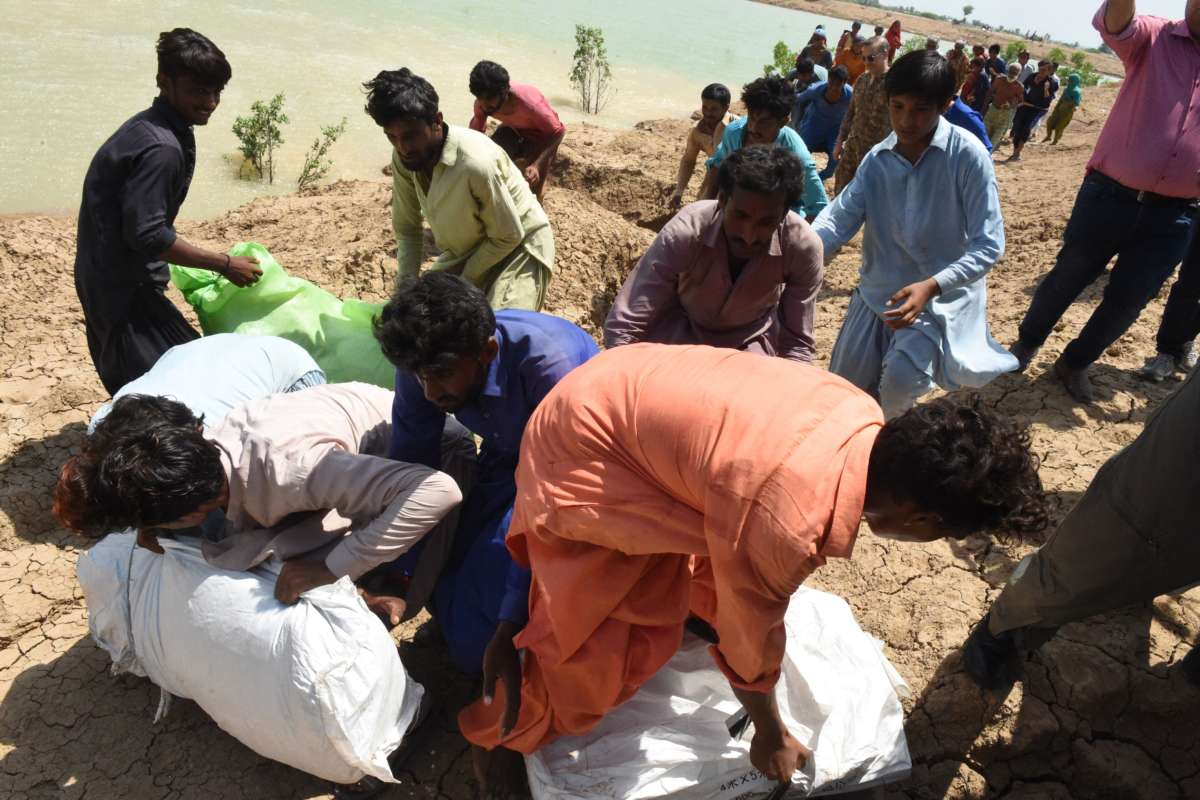Part of the Series
Covering Climate Now
Support justice-driven, accurate and transparent news — make a quick donation to Truthout today!
After weeks of relentless rains, a new cycle of flash floods devastated parts of Pakistan over the weekend, raising the country’s monsoon death toll to 1,136 since June, according to the country’s National Disaster Management Authority. Nearly 1 million homes have been damaged or destroyed and over 33 million Pakistanis affected, with displaced families sleeping on roads, in lean-tos and tents, and in makeshift shelters in schools and mosques.
“This is very far from a normal monsoon — it is climate dystopia at our doorstep,” Sherry Rehman, a Pakistan senator and the country’s climate change minister, told AFP on Monday.
The monsoon season began earlier than normal this year, in mid-June, and the country has experienced its heaviest rain on record since the 1960s. The southern province of Sindh received 784 percent more rainfall this month than the August average and southwestern Baluchistan received 500 percent more, according to the Pakistan Meteorological Department as reported in the New Delhi Times. The department warns that rains could continue into next month.
Aid from Turkey and the United Arab Emirates arrived in Islamabad on Monday for areas that have been hit by what Rehman called “the monster monsoon of the decade.” But distributing supplies will be difficult: Thousands of miles of roads and more than 150 bridges have been destroyed throughout the country. Civilian rescuers and government soldiers are still struggling to evacuate thousands of people marooned in inaccessible areas.
All four provinces of Pakistan have suffered the effects of the floods. Large swathes of the southern Balochistan and Sindh provinces are currently underwater; 75 percent of Balochistan, the country’s least developed province which accounts for half the land area of Pakistan, has been affected.
In the mountainous north, where the Himalayas, the Karakoram and the Hindu Kush ranges meet, glacial lake outburst floods have rushed through valleys, sweeping away bridges and homes. Pakistan is home to over 7,000 glaciers, the highest number in the world outside the polar region; as these melt with global temperature increases, they exacerbate the impact of heavy rain. In the northwestern province of Khyber Pakhtunkhwa, weekend fooding from the Swat River displaced tens of thousands who now await aid at relief camps in government buildings.
By the time the rain recedes, said Rehman, a third of Pakistan could be underwater. The government has declared a national emergency and called for international aid. On Tuesday, the United Nations will launch an international appeal for $160 million in donations.
The disaster comes amid a financial crisis in Pakistan, with the nation facing historic inflation, depreciating currency, and a massive account deficit. On Monday, the International Monetary Fund, or IMF, board approved $1.17 million in bailout funds so that the country can avoid default. The IMF and Pakistan signed a bailout accord in 2019 but the payments from the IMF had been delayed over concerns about Pakistan’s compliance with the deal terms under the government of former Prime Minister Imran Khan. The new government instituted painful economic austerity measures in order to access the funding.
Khan, ousted in April after a constitutional vote of no confidence, has been holding rallies to demand new elections. NPR reported that in remote areas of Pakistan, there’s a sense that the political crisis in Islamabad has drawn attention away from the devastating impacts of the rains until now. On Monday, Finance Minister Miftah Ismail suggested that Pakistan could reopen some trade with India to import vegetables; trade has been blocked since 2019 when New Delhi moved to integrate part of the disputed Kashmir region. Last week, the U.N. said in a statement that it had allocated $3 million for flood response in Pakistan, focusing on the most vulnerable.
Pakistan emits less than 1 percent of the world’s greenhouse gases but consistently ranks among the top 10 most vulnerable countries in Germanwatch’s Global Climate Risk Index. In comments on Sunday, Minister of Foreign Affairs Bilawal Bhutto Zardari pointed out how Pakistan bears the brunt of climate change while high-emitting countries fail to reduce their emissions sufficiently. “Pakistan contributes negligible amounts to the overall carbon footprint,” he said, “but we are devastated by climate disasters such as these time and time again, and we have to adapt within our limited resources.”
Press freedom is under attack
As Trump cracks down on political speech, independent media is increasingly necessary.
Truthout produces reporting you won’t see in the mainstream: journalism from the frontlines of global conflict, interviews with grassroots movement leaders, high-quality legal analysis and more.
Our work is possible thanks to reader support. Help Truthout catalyze change and social justice — make a tax-deductible monthly or one-time donation today.
